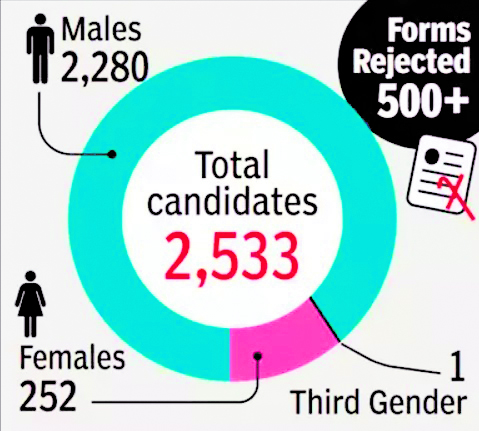
The 16th Legislative Assembly election in Madhya Pradesh has reached its conclusion, marking a pivotal moment in the state’s political landscape. The voters have exercised their democratic right to shape the formation of a new government.
A total of 2,533 candidates, including 2,280 males, 252 females, and one identifying as the third gender, contested in this election. Both the major political parties, BJP and Congress, fielded candidates on all 230 seats, while BSP fielded 181, SP 71, and the Aam Aadmi Party had 66 candidates in the fray. The fate of these candidates and the political parties they represent will be decided on December 3, following the completion of the voting process.
Before delving into the political dynamics between BJP and Congress, it is noteworthy that both parties made concerted efforts to appeal to women voters. The Congress introduced the Nari Samman Yojana, offering a monthly stipend of Rs 1,500, while the BJP launched the Ladli Behna Yojana, providing Rs 1,250 per month. These initiatives aimed to secure support from women voters for the BJP.
In the final days of the campaign, Chief Minister Shivraj Singh Chouhan visited the residence of Ladli Behna Aasha in Bhopal’s Sunehari Bagh, announcing the upcoming Lakhpati Behna Yojana. This scheme proposes a monthly income of Rs 10,000 for women, facilitated through self-help groups. This move underscores the BJP’s focus on attracting women voters, aligning with the concept of a Women’s Vote Bank.
The state, with over 21 lakh young voters, witnessed the introduction of the ‘Sikho Kamao Yojana’ by the government approximately three months before the elections. This scheme involves providing temporary funds to those acquiring new skills. These various schemes reflect the BJP’s strategic approach to the election, considering the prevailing electoral climate.
Collaborative efforts between Delhi and Madhya Pradesh were evident as Kamal Nath, along with Digvijaya Singh, strengthened their political strategy. While the Congress released its manifesto nearly a month ago, sparking discussions about its feasibility, the BJP’s announcement letter surfaced just 3-4 days before the elections. In this communication, the BJP conveyed its decision to present resolutions through a resolution letter, aiming to fulfil them.
As the BJP has been in power for the past three years, questions arise about the fulfilment of resolutions outlined in its letter. Whether due to time constraints or a deliberate strategy to stimulate public discussion closer to the elections, these questions remain unanswered. In response, Kamal Nath raised several queries regarding the BJP’s resolution letter, asserting it as a mere replica of the Congress manifesto.
The electorate, regardless of party allegiance, share a common sentiment that political parties often make grand promises during elections. The true intentions behind these promises will become apparent on December 3. Reflecting on the 15th Legislative Assembly of the state over the past five years, the public has experienced governance under both Congress and BJP. This first-hand experience has equipped the people of Madhya Pradesh to discern which party genuinely fosters development and which merely engages in rhetoric.
As the people await the outcome, the reality behind the claims of both the BJP and the Congress will be unveiled on December 3, determining the political landscape in Madhya Pradesh.